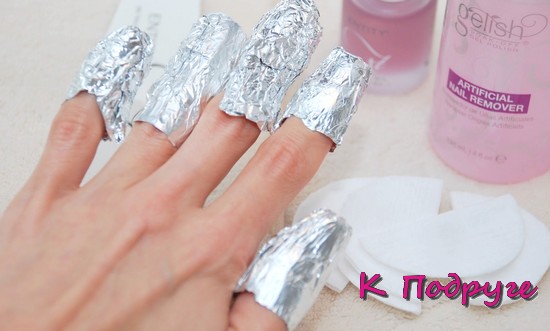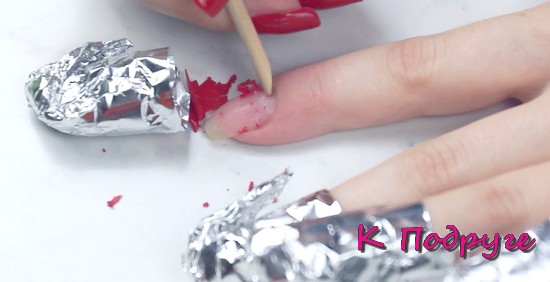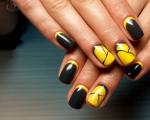How to remove shellac from a nail plate yourself?
Covering your nails with Shellac is a popular and in-demand method of hand care today. This type of manicure has only one obvious drawback: it is impossible to perform the correction on your own, without special equipment. That is why many girls are concerned about the question of how to remove shellac at home.
Why is gel polish so relevant today?
Durable gel and bright varnish combined in one bottle are an amazing tandem that allows you to take comprehensive care of your nails. Unlike other decorative products, Shellac is absolutely harmless - it does not destroy the nail plates, does not cause allergic reactions, and does not have an unpleasant pungent odor. On the contrary, those with fragile “claws” have a chance to strengthen them and protect them from delamination with the help of gel polish.
The product lasts from two to three weeks - no chips, cracks or stains. At the same time, the coating does not fade or lose its special shine - this is the main difference between shellac. It is also important that it is suitable for application to nail plates of any length and shape, it looks natural and pretty. With an abundance of pros, there is only one minus - not all girls imagine how to remove such beauty on their own if the need arises.
The note! Do you want “predatory motifs” on your nails? Then make one for yourself - it’s the same gel polish, with the main difference - metal particles are added to the tube, which “draw a hunter” using a magnet.

Recommendations and Cautions
There are special liquids for dissolving acrylics and shellacs, which can be found in professional stores or salons. Their cost is comparable to high-quality products for removing standard manicure (depending on the manufacturer - in the range of 100-350 rubles per bottle, which will last for a long time).
The main advantage of such liquids is their gentle action. The preparations do not irritate the skin of the fingers and do not emit a harsh “chemical” odor. Often the composition includes additional useful substances, for example, vitamins that promote nail growth and strengthen them.
If you can’t find anything similar, there are two simpler options left:
- acetone (from any hardware or repair store);
- liquid for removing regular nail polish such as “Laska” or “Dream”.

The main unpleasant difference between these products is the possibility of an allergic reaction or chemical burn to the fingers. To prevent this from happening, proper preliminary preparation is required: before the shellac removal procedure, lubricate the skin around the nail well with a rich cream. However, if you are intolerant to liquids containing acetone, you will have to abandon the “cheaper” method altogether - in order to avoid consequences.
To “soak” the coating, you will need hygroscopic pads that are wetted in a solvent liquid. This role is played by sponges, pieces of sanitary pads or lumps of cotton wool. They are attached to the fingers using foil (you can use special clips or elastic bands). The easiest way to remove softened gel polish is with special manicure spatulas or a classic orange wood stick.
How to remove shellac from nails at home?
Foil as a fixative - a classic home “tool”
When making Shellac, different bases are used, the thicker they are, the harder it is to remove the product. In any case, you will first need to remove the last, shiny layer from the nail plates, and only then begin to dissolve and remove the base. At this stage you will need to use a saw or a special router.
The following list of “useful things” looks like this:
- foil, cut into small squares;
- cotton pads;
- special solvent for bio-gel, gel polish (less aggressive compared to conventional acetone products).
A cotton pad should be cut into small pieces similar to the size of a nail and moistened with solvent. Each piece is applied to the nail from the cuticle, tucked over the outer edge, and then the phalanx of the finger is wrapped in foil - it acts as a retainer. It will take 10 to 15 minutes to “soak” the shellac. In a warm room the process will go faster; in a cool room it may take longer.
Please note: often gel polish can be easily removed from the entire nail, but it absolutely does not want to come off from its tip. To cope with the problem, try at the preparation stage not only to damage the top coating on the main part of the plate, but also to “sharpen” the edge. If you wish, you can do without foil, replacing it with small, tight elastic bands.
For further manipulations, you will need a device that can be used to scrape off the remaining shellac from the nail (for example, a metal spatula). You should move from the cuticle to the edge, in the direction of nail growth, so as not to split it. The remains of the base are cleaned off with a slightly abrasive buff. The final touch: wash your hands and lubricate your fingers well with nourishing cream.
4 methods for “every taste”
There are “secret ways” to remove Shellac to suit every taste. It remains to evaluate their convenience and effectiveness.
- Mechanical removal of shellac using a nail file with an abrasiveness of 150 grit. A long and labor-intensive process that does not require additional costs.
- The same file plus special wipes soaked in softening liquid. They are packaged in small envelopes made of foil paper. The algorithm is as follows: remove the upper, glossy part of the nail coating with a nail file, cut the bag on one side, stick your finger into it (so that the napkin is on top of the phalanx). Fold the edges of the envelope, wait a quarter of an hour. Remove the softened shellac with an orange stick, clean the edge with a file. The method does not require serious effort, but you will have to tinker with the edges of the marigolds longer - they do not soak very well.
- You need a container made of glass or metal into which you will pour liquid to dissolve artificial nails (acrylic). Lubricate each finger generously with rich cream, paying special attention to the cuticle. Place your nails in a bowl, hold for 15 minutes, then peel off the coating according to the algorithm of method No. 2. The method is convenient and simple, the gel polish is easily removed. The main thing is that the skin does not become irritated upon contact with the solvent.
- The main tool is a ceramic cutter. Having turned on the machine at a speed of 15 to 30 thousand revolutions, we begin to cut down the coating (first along the perimeter, and then in the center). The method is fast and convenient.




